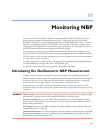
Perfusion (Pleth) Indicator 9Monitoring SpO
2
141
Perfusion (Pleth) Indicator
The perfusion indicator gives a numerical value for the pulsatile portion of the measured signal caused
by the pulsating arterial blood flow.
As pulse oximetry is based on the pulsatile nature of the signal, you can also use the perfusion indicator
as a quality indicator for the SpO
2
measurement. Above 1 is optimal, between 0.3-1 is acceptable.
Below 0.3 is marginal; reposition the sensor or find a better site.
Setting SpO
2
/Pleth as Pulse Source
1 In the Setup SpO2 menu, select Pulse (SpO
2
) to enter the Setup Pulse menu.
2 In the Setup Pulse menu, select System Pulse and select SpO
2
from the pop-up list.
Setting Up Tone Modulation
If tone modulation is on, the QRS tone pitch lowers when the SpO
2
level drops. Remember, the QRS
tone is derived from either heart rate or pulse depending on which is currently selected as the active
alarm source.
♦ In the Setup SpO
2
menu, select Tone Modulation to toggle between Yes (for on) and No
(for off).
Tone modulation is licensed under US patent US 4,653,498 from Nellcor Puritan Bennett
Incorporated, a Tyco Healthcare company.
Setting the QRS Volume
♦ In the Setup SpO
2
menu, select QRS Volume and set the appropriate QRS tone volume.
Calculating SpO
2
Difference
When a second SpO
2
measurement is present (either through the SpO
2
module or through VueLink),
the monitor displays both SpO
2
values, and calculates the difference between them. The second value
is subtracted from the first.
minimum size for reliable SpO
2
value


















